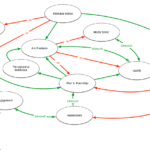Agile teams have been struggling since the earliest days with how to bring new people on to a team. In one of the first Agile books, there was a story of Alistair Cockburn walking a new hire through the team’s flip charts and telling the story of their work. I haven’t seen a team use […]
Agile culture
Scrum by Example – Team Friction Inspires Working Agreements
Scrum team Working Agreements are a simple, powerful way of creating explicit guidelines for what kind of work culture you want for your Team. They are a reminder for everyone about how they can commit to respectful behaviour and communication. In this post we’ll see how the fictional World’s Smallest Online Bookstore (WSOBS) Scrum team struggles […]
Agile Bonuses – The Damage They Do
A design pattern is a description of a solution to a recurring problem. It outlines the elements that are necessary to solve the challenge without prompting the reader to address the issue in a specific way. Unfortunately, we also regularly see recurring patterns of ineffective behaviour. These are called Anti-Patterns. The following explores the common […]
Future Perspective for Change: Why Backcasting Helps Get You Where You Want to Be
When a product team starts work on a product, it’s important that they understand the vision. This is, as they say, a bit of a no-brainer since otherwise they might build something that completely misses the mark. In a modern Agile world, we’re expecting a mix of Product Management, Developers, ScrumMaster, the Customer and perhaps […]
Red-Yellow-Green Status Reports and Other Models – How They Should and Shouldn’t Be Used
Red-Yellow-Green status reports are a widely-used tool to help executives have a fast and simple understanding of the current state of a project through a visual model that makes it easy to spot patterns. Green means everything is good, yellow means there’s some risk, and red means the project is in serious trouble. Simple, right? […]
Scrum Anti-Patterns: Micromanagement
A design pattern is a description of a solution to a recurring problem. It outlines the elements that are necessary to solve the challenge without prompting the reader to address the issue in a specific way. Unfortunately, we also regularly see recurring patterns of ineffective behaviour. These are called Anti-Patterns. The following is an exploration […]
What Are the Limits of the Scrum Framework?
Frequently in workshops, I get asked, “Where shouldn’t we use Scrum?” The short answer is there are lots of instances where the Scrum framework doesn’t fit. However, to give a more complete and effective answer to this question, first we need to have an idea of why and when Scrum does work and what the […]
The Role of Agile Managers: Why Job Titles Are Dangerous
Managers transitioning from waterfall to Agile will need to renegotiate their relationship with their teams if they are to succeed. A manager cannot simply become an Agile Manager – a big part of a transition requires a rethinking of how job titles are assigned and the leadership responsibility that comes with them. I was recently […]







